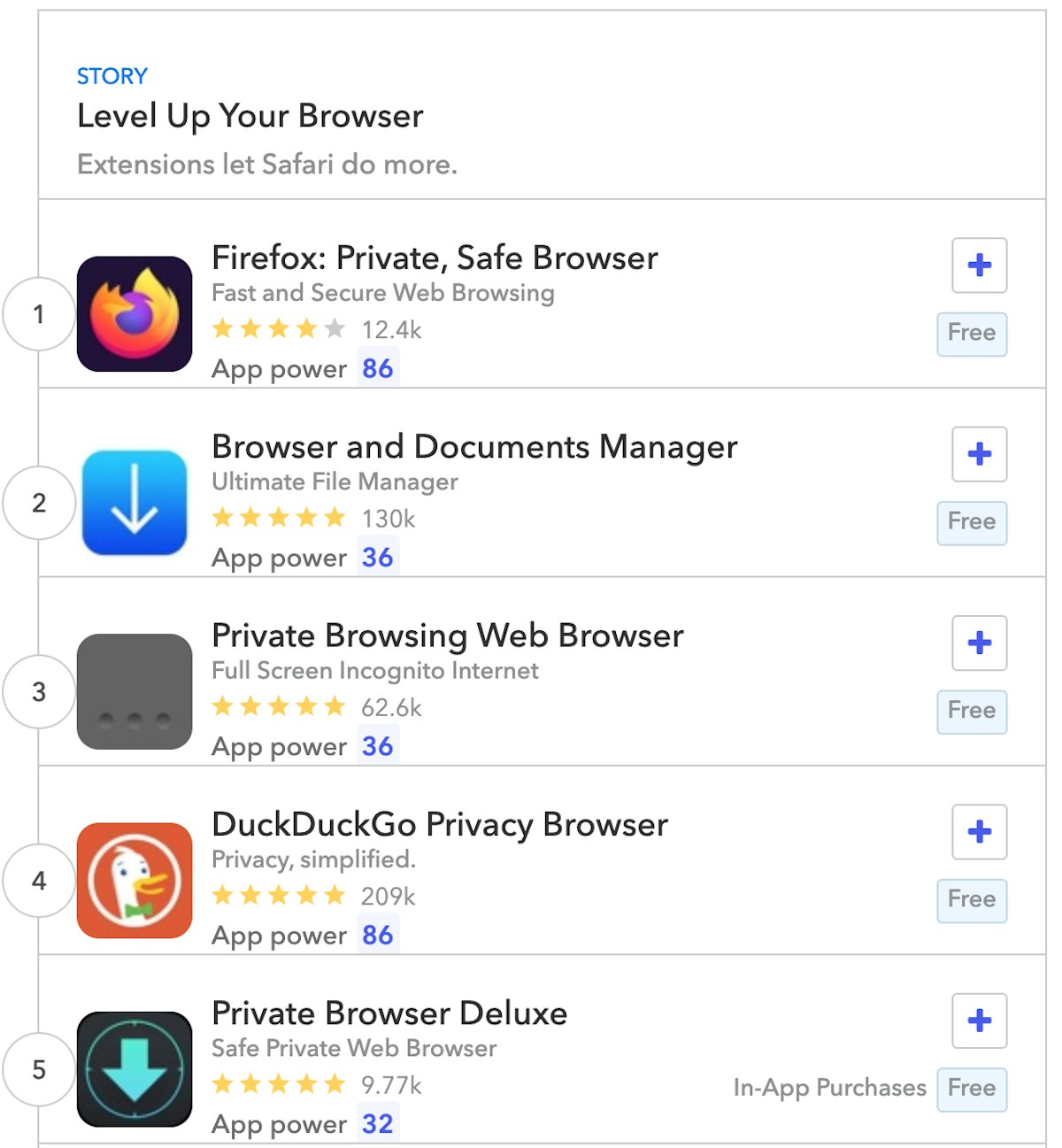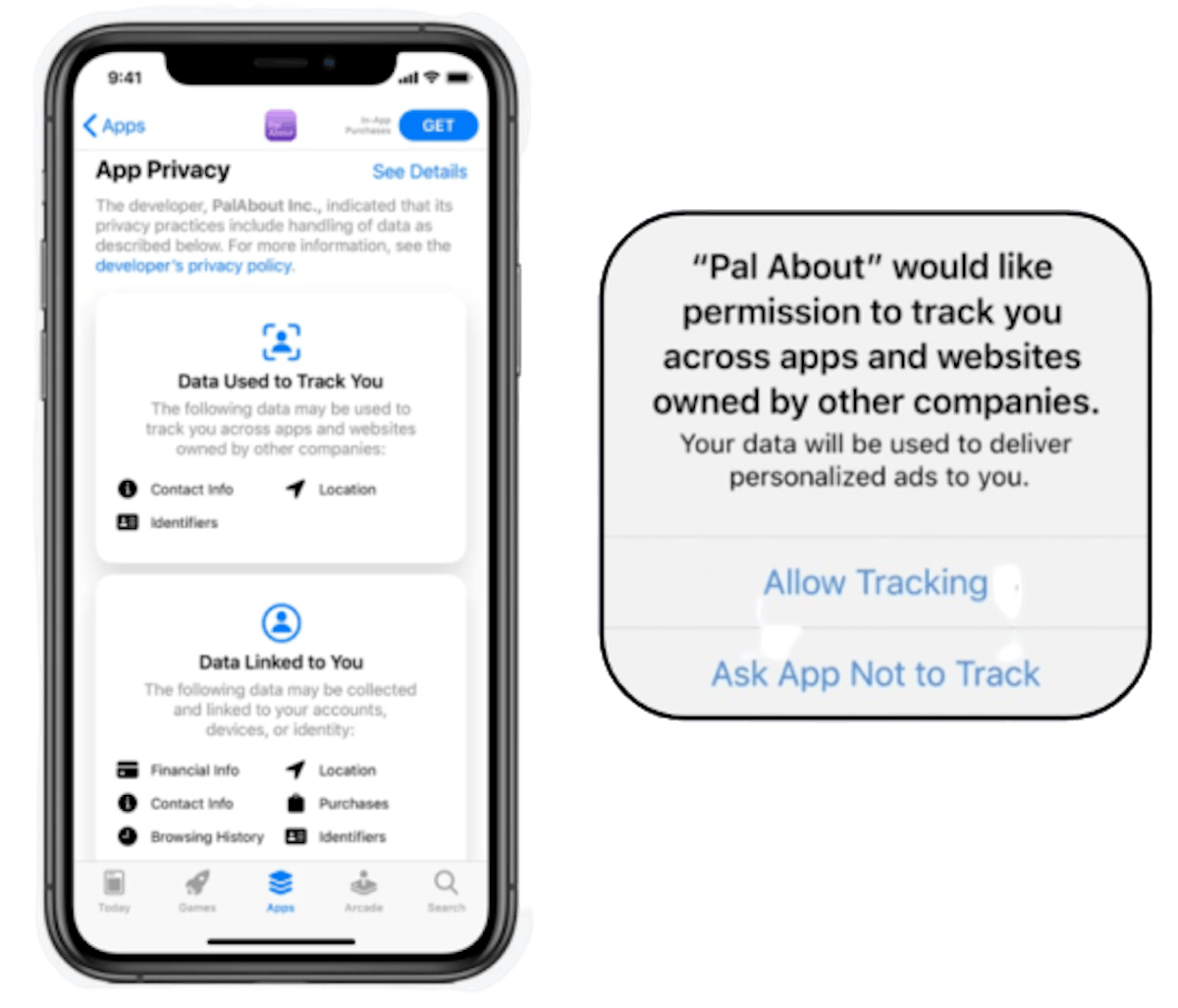
Apple의 개인 정보 보호 업데이트 및 ASO에 미치는 영향
지난 2년 동안 개인 정보 보호는 모바일 사용자들에게 점점 더 인기 있는 주제가 되었으며, 이는 미국에서는 COPPA, EU에서는 GDPR과 같은 규제를 입법자들이 도입하게 만들었습니다. 많은 기업들도 이 주제를 주요 사용자 관심사로 인식하고 있으며, 일부는 규제 표준을 넘어선 조치를 취하고 개인 정보 보호를 핵심 제품 혜택의 일부로 만들고 있습니다.
지난주 Apple은 WWDC 온라인 행사 발표에서 개인 정보 보호에 큰 초점을 맞췄으며, 여기에는 iOS 14의 일부로 몇 달 안에 출시될 여러 영향력 있는 개인 정보 보호 관련 제품 업데이트가 포함됩니다. 이러한 발표에 따라, 우리는 개인 정보 보호 친화적인 사용자 확보에서 ASO의 잠재적 역할에 대해 더 자세히 살펴보기로 했습니다.
지금까지 개인 정보 보호가 ASO에 미친 영향
지금까지 ASO와 사용자 개인 정보 보호 간의 상관관계는 많이 연구되지 않았지만, 이 둘이 서로 아무런 관련이 없다고 가정하는 것은 잘못된 생각일 것입니다.
- 특히 서구 시장에서 개인 정보 보호가 점점 더 큰 관심사가 되면서, ASO에 미치는 첫 번째 영향은 개인 정보 보호 관련 키워드로부터의 트래픽 증가와 개인 정보 보호 관련 이점을 보여주는 스크린샷으로부터의 전환에 미치는 잠재적 영향입니다.

6월 25일 미국 App Store에서 “브라우저” 검색 결과로 표시된 상위 5개 앱 중 4개는 제목에 “private” 또는 “privacy”라는 단어를 포함하고 있습니다.
- 규제 강화에 따라 Apple과 Google은 모두 사용자 개인 정보 보호에 대한 가이드라인을 강화했으며 앱 제출 거부의 새로운 근거를 도입했습니다. 이 새로운 가이드라인 중 일부는 어린이 앱에 중점을 둡니다. 그 결과, 개발자들은 최근 몇 년 동안 스토어 콘솔에 추가 정보를 몇 차례 제공해야 했습니다(예를 들어, 앱이 어린 사용자를 대상으로 하는지 여부를 공개하고 사용할 수 있는 광고 네트워크가 Apple의 승인을 받았는지 확인하는 것). 대부분의 변경 사항은 최종 사용자에게 직접적인 영향을 미치지 않는 것으로 보였습니다. 그러나 Android 앱이 미성년자를 대상 고객으로 하는지 여부를 표시하도록 요구되면서 Google Play 앱 제품 페이지에 보호자 지침 로고가 나타나는 간접적인 영향이 있었습니다.
- Google Play에서 앱에서 침입적인 SDK를 제거하기로 선택한 개발자는 Google의 알고리즘이 더 작은 앱 크기를 긍정적인 Android 필수 요소로 간주하기 때문에 앱 가시성에서 약간의 이점을 얻을 수 있습니다.
App Store와 Google Play의 ASO 차이점 이해
iOS의 다가오는 개인 정보 보호 변경 사항 및 사용자 확보에 미치는 영향은 ASO에 새로운 역할을 부여할 수 있습니다.
WWDC 2020에서 Apple은 iOS 14가 앱 페이지에 앱 작동에 필요한 접근 권한을 상세히 설명하는 개인 정보 보호 카드를 포함하도록 요구할 것이라고 발표했으며, 더 중요하게는 사용자는 기본적으로 “광고 추적 제한”(LAT)이 활성화됩니다.

iOS 14는 앱 스토어 제품 페이지에 개인 정보 보호 섹션을 포함하고, 개발자가 사용자에게 추적을 허용하도록 요청할 수 있는 가능성을 제공할 것입니다.
기본적으로 LAT가 활성화되는 변경 사항은 대부분의 사용자에게 눈에 띄지 않을 가능성이 높지만, 이는 향후 UA(사용자 확보)가 수행되는 방식에 중대한 영향을 미칠 것으로 예상됩니다. 즉, IDFA로 알려진 기기 식별자 토큰이 더 이상 타사 서비스와 공유되지 않을 것입니다. 이는 대부분의 광고주가 IDFA를 사용하여 광고 클릭과 앱 열기를 일치시켜 사용자가 앱을 설치했는지 확인하고, 이를 통해 설치당 비용과 관련된 마케팅 캠페인의 성과를 최적화하는 타사 어트리뷰션 플랫폼에 의존하기 때문에 UA에 엄청난 변화를 가져올 수 있습니다.
iOS 14의 새로운 기능과 ASO 작업에 미치는 영향 알아보기
그렇다면 이것이 ASO와 무슨 관련이 있을까요? 간단히 말해, IDFA의 사실상 사라짐(기술적으로는 옵트인한 사용자에게 계속 제공되겠지만)은 광고주들이 사용자 유입 경로를 이해하기 위해 App Store 데이터와 예측 모델링에 더 많이 의존하도록 강제할 수 있습니다. 이를 위해 ASO는 사용자 확보 전략과 예측 모델링 모두에서 핵심적인 역할을 할 가능성이 높습니다.
- ASO 도구를 사용하여 스토어 트래픽 및 키워드 트렌드를 모니터링하는 것은 데이터 분석가가 앱 사용자 기반 변동의 근본적인 현상을 이해하는 데 유용한 정보를 제공할 수 있습니다.
- 동시에, ASO 및 UA 관리자 간의 긴밀한 협력(특히 크리에이티브 최적화와 관련하여)은 사용자가 유지율을 높이는 가장 가치 있는 기능에 대해 알 수 있도록 하는 데 중요할 것입니다. 그 결과, 이는 앱 설치 수준뿐만 아니라 다운스트림 지표에서도 전환을 극대화할 것입니다. 이는 오늘날에도 ASO와 UA가 항상 함께 작동하지 않고 서로 다른 메시지와 지표에 대한 최적화로 이어지는 사일로화된 구조를 가질 수 있기 때문에 많은 앱 회사에게 조직적인 과제가 될 수 있습니다.
앞으로의 과제: 스토어 콘솔의 더 많은 데이터에 대한 기대
어트리뷰션의 다가오는 변화가 ASO의 중요성을 높일 가능성이 높지만, 이는 ASO 실무자들의 현재 문제를 해결하지 못합니다. ASO에서 ROI 측정은 복잡한 주제로 남아 있으며, ASO 도구는 이미 고급 추정 모델을 개발했지만, 추정에 필요한 App Store Connect에서 현재 사용 가능한 데이터 양에 의해 여전히 제한되기 때문입니다.
ASO가 앱 성장 전략의 핵심 요소인 이유를 정확히 이해하기
따라서 스토어 콘솔에서 사용 가능한 데이터의 양과 질을 모두 개선하는 것이 Apple에게 다음 주요 논쟁점이 될 것입니다. 개발자와 마케터는 스토어 콘솔의 추가 어트리뷰션 지표에 대해 높은 기대를 가질 가능성이 높으며, 특히 Google Play가 콘솔에 오랫동안 기다려온 개선 사항을 적용한 후에는 더욱 그럴 것입니다. 물론 Apple이 App Store Connect에 데이터를 추가하기 위해 특별한 노력을 기울일지, 또는 광고주에게 개인 정보 보호 친화적인 데이터를 제공하기 위한 다른 옵션을 모색할지는 알 수 없습니다. 그러나 WWDC에서 발표된 또 다른 iOS 14 기능은 Apple이 App Store Connect에서 데이터 기능을 개발하여 iOS에서 선호되는 성능 측정 플랫폼으로 만들도록 유도할 수 있습니다: 바로 App Clips입니다.

App Clips는 사용자가 다운로드 없이 호환되는 앱에 제한된 접근을 허용하고, Apple로 로그인 및 Apple Pay를 통한 원활한 사용자 등록 및 구매를 지원할 것입니다.
App Clips는 개발자가 사용자에게 앱을 다운로드하지 않고도 부분적인 접근 권한을 부여하여, 사용자가 앱을 검색할 필요 없이 제품을 경험하게 해줍니다. 사용자 확보 퍼널의 사용자 경험을 개선하는 이점은 명백하고 논쟁의 여지가 없습니다. 그러나 아직 제시되지 않은 것은 App Clips에서 발생하는 트래픽과 앱 설치가 App Store Connect에서 어떻게 측정될 것이며, 어떤 수준의 데이터 세분화로 측정될 것인지입니다.
여기서는 추측만 할 수 있지만, Apple이 App Store Connect에 새로운 지표를 도입하여 개발자에게 App Clips의 가치를 보여주고, 이를 통해 수신하는 트래픽과 새로운 iOS 14 기능으로 인해 발생하는 앱 설치 수를 측정할 수 있도록 할 가능성이 높습니다. 또한, “메시지” 및 “지도” iOS 앱에 App Clips에 대한 통합 기능이 이미 개발되어 있으므로, Apple이 다른 앱들도 App Clips 공유 기능을 지원하도록 장려할 가능성도 배제할 수 없습니다.
만약 그렇다면, 가장 인기 있는 App Clips가 어디에 배치되었는지 측정해달라는 요청이 분명히 있을 것입니다. 예를 들어, 웹의 UTM과 유사한 마크업 로직을 사용하여 개인 데이터를 수집하지 않고 상황별 정보를 통해 사용자 유입 경로를 파악하는 방식입니다. 이러한 시나리오는 순전히 가설적이지만, 동시에 발생하거나 심지어 Apple의 SKAdnetwork 개선에 대한 대안이 될 수도 있습니다. SKAdnetwork는 광고주가 캠페인을 최적화하기 위해 데이터를 어떻게 받을지에 대해 많은 UA 전문가들의 관심사였습니다.
이러한 변화가 일어나 모바일 마케팅 도구 중에서 App Store Connect에 새로운 중요성을 부여한다면, ASO는 성장 전략의 중심에 놓이면서 급격한 변화를 겪을 수 있으며, 동시에 스토어 콘솔의 데이터 분석에 훨씬 더 높은 비중을 두어 그 본질 자체를 변화시킬 수 있습니다.
이 블로그에서는 Apple의 개인 정보 보호 업데이트가 앱 스토어 최적화에 미치는 영향을 강조하며, 개인 정보 보호 친화적인 사용자 확보 생태계에서 ASO가 수행할 수 있는 역할을 살펴보았습니다. 특히 ASO 도구를 사용하여 스토어 트래픽 및 키워드 트렌드를 모니터링하는 것이 훨씬 더 중요해질 것이며, ASO 및 UA 관리자 간의 긴밀한 협력은 전환 및 유지율을 극대화하는 핵심 부분이 될 것입니다.
AppTweak의 ASO 도구를 사용하여 앱 성장을 촉진하는 방법을 알아보고 싶으신가요? 지금 7일 무료 체험을 시작하세요.



 Oriane Ineza
Oriane Ineza

 Micah Motta
Micah Motta
